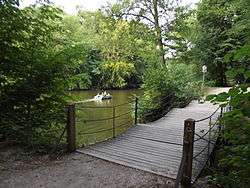Steinfurter Bagno
The Steinfurter Bagno is a park near the town of Burgsteinfurt in the German state of North Rhine-Westphalia.



History
Amusement park
It was founded in 1765 by Count Charles Paul Ernest of Bentheim-Steinfurt with the intention to create a summer residence for his family. The initial design followed the tradition of the French garden which imposes strict order and symmetry on the layout. Following the succession of Count Louis in 1780, the park saw the addition of various buildings and structures, among them the so-called Greece and Egypt, and the imitation of Oriental and Far-Eastern styles. The oldest surviving layout dates back to 1787 which features 105 buildings, fountains, bridges, statues, islands, gardens and paths cramped onto an area of just 125 ha.
In later years, criticism on the excessive density of objects and architectural styles and the rise of the English garden brought about substantial change to the Bagno. Buildings and other objects were removed, new ones constructed; straight ways were replaced by meandering paths, natural looking yet artificial cascades were built, large lawns created and exotic trees planted. The Bagno developed into the most prominent park of Westphalia boasting extraordinary fountains, a widely known chapel, and a lake navigated by a fleet of small yet pompous ships. In a rather modern move, the Count opened the park to the general public.
French occupation
The park experienced a sudden change in 1806 when Napoleon's vassals seized the county. Count Louis traveled to Paris to talk to the French emperor in person and reclaim his position, but to no avail. His son Alexius maintained the park on scant means, and saw himself forced to demolish a number of buildings for want of money for their maintenance. By 1828 only 16 of the 39 buildings counted in 1806 remained; of these 3 remain to this day.
Restoration
State contributions of 4.1 million Euros helped reshape the Bagno in 2004; the refurbished concert hall has gained particular popularity since. In 2006 the park became a member of the European Garden Heritage Network.[1]
References
- ↑ "European Garden Heritage Network" (PDF). muensterland-tourismus.de. Retrieved 2013-08-05.
Further reading
- Döhmann, Karl Georg; Das Bagno, Geschichte des Fürstlich Bentheimschen Parks Bagno bei Burgsteinfurt, 2 Teile, Burgsteinfurt 1907, 1909
- Korzus, Bernard; Das Bagno in Steinfurt, in: Gärten der Goethezeit, Hsg. Harry Günther, Leipzig 1993
- ders.; 1792 im Potsdamer Neuen Garten, in: Wieder wandelnd im alten Park, Beiträge zur Geschichte der Gartenkunst...,Potsdam 1993
- Lübbers, Wolfgang; Das Bagno bei Burgsteinfurt – Versuch einer Rekonstruktion, Steinfurt 1992
- ders.; Das Bagno in Steinfurt - Ein Garten der Goethezeit, Steinfurt 1997
- Pries, Hans-Walter; Das Steinfurter Bagno, Alte Beschreibungen und Ansichten, Greven 1988, Schriftenreihe des Kreisheimatbundes Steinfurt, Bd. 5
- Strohmann, Dirk; Der Konzertsaal im Bagno-Park Burgsteinfurt, Wege zur Wiederherstellung eines Baudenkmals, Münster 1987
- ders.; Die Konzertgalerie im Burgsteinfurter Bagno, in: Westfalen, Hefte für Geschichte, Kunst und Volkskunde, Bd. 67, Münster 1989
External links
- Description on the European Garden Heritage Network website
- Description by the local tourist information
- Website of the concert hall (in German)
Coordinates: 52°08′26″N 7°21′24″E / 52.14056°N 7.35667°E